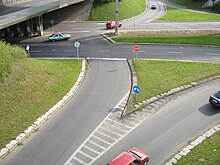Gore (road)


A gore (modern British English: nose)[1] refers to a triangular piece of land. Etymologically it is derived from gār, meaning spear.[2]
Gores on highways are categorized as two types: the theoretical gore and the physical gore. The physical gore is the unpaved area created between the highway mainline and a ramp that merges into or diverges from the mainline.
The theoretical gore is the marked area of pavement resulting from the convergence or divergence of the edge lines of the mainline and ramp. Theoretical gores are commonly marked with transverse lines or chevrons (much as ghost islands) at both entrance and exit ramps. These help drivers entering the highway to estimate how much time they have to match the speed of through traffic, and warn drivers improperly exiting the highway right down the middle of a gore that they are about to run out of road. Gores at exit ramps occasionally feature impact attenuators, especially when there is something solid at the other end of the gore.
See also
References
- ^ "Design Manual for Roads and Bridges" (PDF). Feb 2006. p. 1/2.
- ^ Skeat, Walter William (1901). A Concise Etymological Dictionary of the English Language. Oxford: Clarendon Press. p. 218.
External links
 Media related to Gore (road) at Wikimedia Commons
Media related to Gore (road) at Wikimedia Commons
